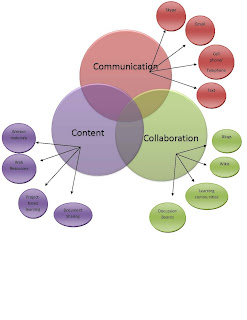There are several ways to bring the technological tools learners are using outside the classroom into the educational process in order to build content knowledge, engage in communication with peers and instructors, and work on authentic, collaborative, problem-based tasks in the online environment. To build content knowledge, the instructor must provide written materials, such as text books and articles. These resources support the skills that are being taught. Web resources are tools which enhance the knowledge building content. Project-based learning provides students with a more meaningful learning experience. Document sharing is another resource tool that provides students with more resources and information to enhance their learning experience.
There are many technological tools that can be used to engage communication with peers and instructors. Skype is a form of communication that allows you to visually communicate with another person. Emails provide written communication between just one or several people. Texting is a quick and easy form of communication. The use of the cell phone/telephone is the standard way of communicating.
Wikis are one tool that allows students to work on authentic, collaborative, problem-based tasks. Members of a learning community can provide feedback to other team members. Blogs are also another technological tool that can be incorporated into the online environment. Discussion boards allow peers and instructor to share their thoughts and ideas. Learning communities gives peers to do small group assignments in the online environment similar to the traditional face to face environment.
The use of technological tools helps to engage learners in an online environment. A lot of the tools are currently being used by the learners on a daily basis so incorporating them into the learning environment will further enhance their learning experience by building on their content knowledge and engaging in communication with their peers and instructor.
Anderson, T. (Ed.). (2008). The theory and practice of online learning (2nd ed.). Edmonton, AB: Athabasca University Press.
Durrington, V. A., Berryhill, A., & Swafford, J. (2006). Strategies for enhancing student interactivity in an online environment. College Teaching, 54(1), 190-193.
Siemens, G. (2008, January). Learning and knowing in networks: Changing roles for educators and designers. ITForum.

Good graphic organizer Charee and good post. You have clearly identified tools that enhance the distance education environment and engage online learners. You mentioned document sharing and Google Docs is a free online resource for enabling such collaboration. The software allows for the editing, publishing, and presentation of documents. It is accessible to any student involved in collaborative group activity who has Internet access.
ReplyDeleteCharee,
ReplyDeleteMany of your tools in your graphic organizer are tools that kids are using on their own. That is a great point, and I think those are easy ways to integrate technology that gets them interested in what they are learning. I enjoyed reading your post and appreciate that it allowed me to see a different way of thinking.
To add to Vida's suggestion of Google Docs, I received an email today from Microsoft about SkyDrive, which allows anyone to edit files created in Microsoft Office software, even if they do not have the software. It allows multiple people to edit, so it can also be used as a collaborative tool.
Thanks!
Charee-
ReplyDeleteYour thoughts and ideas you presented in your graphic organizer were similar to mine. I had a difficult time placing some components as I felt they could be related to multiple categories. Did you find this true as well?
Great post!
Heather
Charee,
ReplyDeleteI love the tools that you have chosen. Many of them I also chose. The tools that allow a person to have more personal communication such as Skype are wonderful. This allows a student to put a face with a name. I enjoy seeing everyones pictures on their blog.
Wikis are also an excellent tool for collaboration. I know a science teacher who used them in his high school classroom. The students learned so much more by using wikis. It was a wonderful project.
Charee - I like your comment about using tools that people use on a daily basis. This is a good way to make students feel more comfortable in the classroom, too.
ReplyDelete